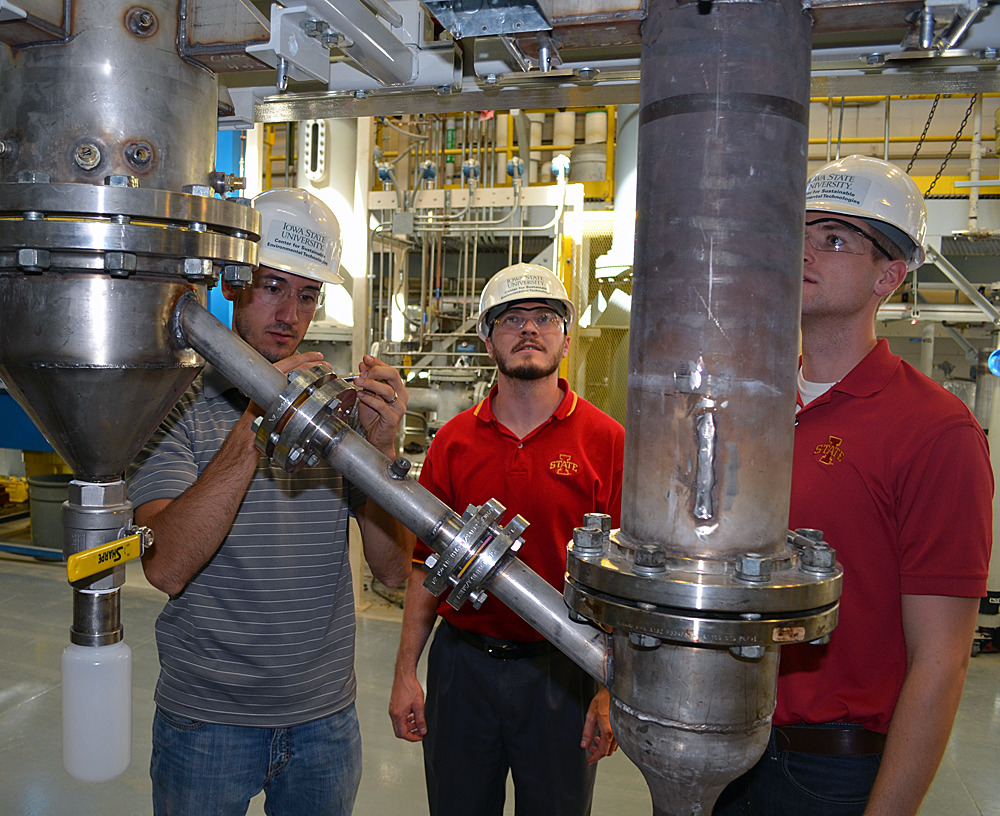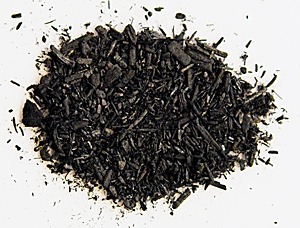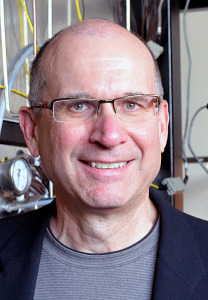
Jordan Funkhouser, Lysle Whitmer and Marty Haverly, left to right, helped redesign and rebuild Iowa State's fast pyrolysis pilot plant. Larger photo. Photo by Bob Mills of the Bioeconomy Institute.
AMES, Iowa – Iowa State University’s Robert C. Brown doesn’t talk about simply reducing carbon emissions. He talks about reversing the petroleum economy’s cycle of extract, burn and emit.
“Can you imagine if we reverse that by drawing down carbon and still building the economy?” asked Brown, an Anson Marston Distinguished Professor in Engineering, director of Iowa State’s Bioeconomy Institute, the leader of the College of Engineering’s Initiative for a Carbon Negative Economy and the Gary and Donna Hoover Chair in Mechanical Engineering. “We can do that if we have a renewable energy process based on photosynthesis and a carbon sequestration process.”
Here’s how that process could work:
Plants grown for renewable fuels would pull carbon dioxide from the atmosphere. Leaves, stems and stalks would be harvested and broken down by quickly heating them without oxygen, a process called fast pyrolysis. One of the products of fast pyrolysis is a thick, dark oil that can be burned for power generation or processed into transportation fuels. Researchers sometimes describe bio-oil as densified biomass that’s much easier to handle and transport than raw biomass.
Pyrolysis also produces biochar, a carbon-rich solid similar to the charcoal produced by fire. Biochar applied to farm fields sequesters carbon and improves soil fertility. Brown said biochar makes big improvements to poor soils. Improvements are smaller in Iowa’s already rich soils.
The cumulative result of the entire process? “Carbon negative energy,” Brown said.
The Initiative for a Carbon Negative Economy is one of three Dean’s Research Initiatives launched in 2011 by Iowa State’s College of Engineering. The three projects (the others are in wind energy and computational biology) received three-year, $500,000 grants to build the interdisciplinary faculty teams and public-private partnerships that can successfully compete for multi-million dollar research grants. All three research initiatives are designed to develop new technologies and spark economic development.
Brown said the early work of the carbon negative initiative was focused on building a team, creating the intellectual foundation for a carbon negative economy and writing a lot of grant proposals to attract support for research projects in pyrolysis, energy production, biochar application and carbon economics.
To date, the initiative has attracted three significant research grants:
- Nearly $2 million from the Global Climate and Energy Project based at Stanford University in California. Agronomists, engineers and economists will use the grant to develop comprehensive computer models of the costs and benefits of a pyrolysis-bioenergy-biochar approach to a carbon negative economy. David Laird, a professor of agronomy, is leading the modeling project.
- $500,000 from Iowa State’s Leading the Bioeconomy Initiative, which is supported by a $7.5 million appropriation from the state. Researchers will use the grant to mix bio-oil created by pyrolysis with the coal burned in Iowa State’s Power Plant. Researchers will also apply the biochar produced by pyrolysis to farm fields. At the Power Plant, they’ll study combustion performance and look for reductions in emissions. In the fields, they’ll look at soil health and increases in crop yields. Brown is leading the demonstration study.
- $75,000 from the Iowa Energy Center. The grant will support the redesign of a pyrolysis machine owned by the Stine Seed Co. of Adel. The company will use the design to retrofit and improve its 30-ton-per-day pyrolyzer. The company will also allow Iowa State researchers to use the machine to produce bio-oil and biochar for carbon negative studies. Lysle Whitmer, a program coordinator for Iowa State’s Center for Sustainable Environmental Technologies, is leading the design project.
Brown said the initiative’s next step is to secure funding for a much larger demonstration project in carbon negative energy.
In the meantime, initiative leaders will continue to work with a national panel of engineers, scientists, economists and business leaders to gain support for the idea of a carbon negative economy.
“Most natural ecosystems on the planet operate as carbon negative processes – except for human societies,” Brown said. “The original prairies did. The oceans do. They draw down carbon and sequester it. And now we want to demonstrate that we can operate as a carbon negative economy.”

